


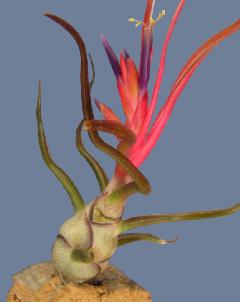
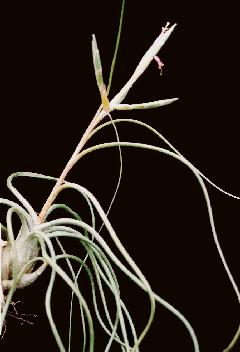

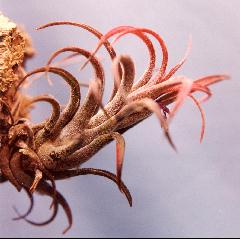
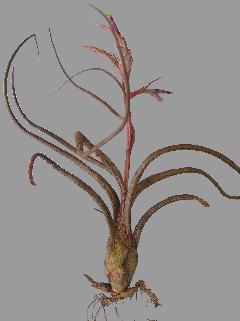
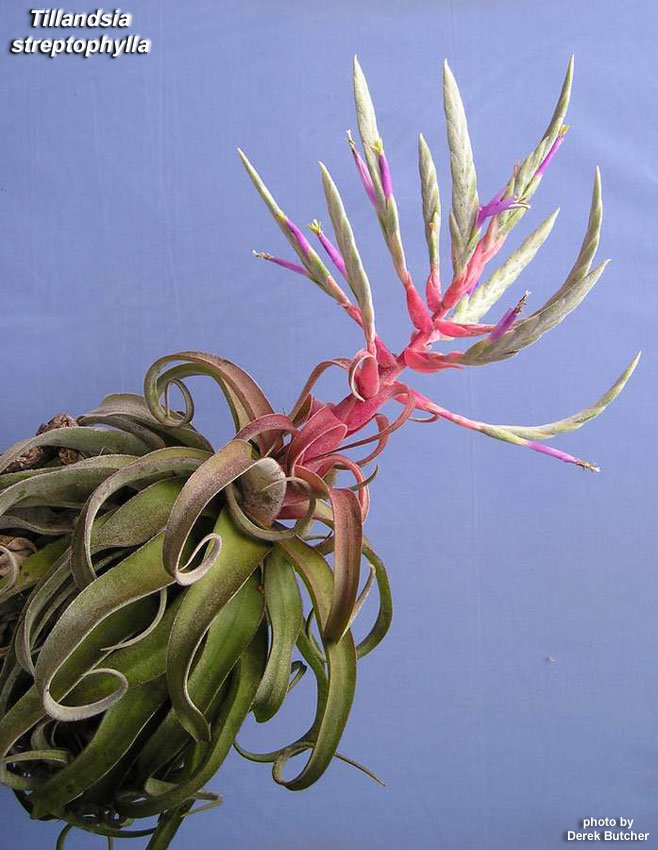
Air-plant Bromeliads and More.
Here however, we are concerned primarily with a small group of species within a larger assembly of atmospheric Tillandsia species known popularly as air plants. Atmospheric Tillandsia are species that manage to survive in what are intolerable sites for many other vascular epiphytes. The word vascular in botany includes all “higher” plants, those with water conducting tissues such as ferns, fern allies and all flowering plants.
Some air-plant species such as the so-called Ball Moss Tillandsia recurvata are able to live extremely successfully in exceptionally exposed positions such as on enormous and extremely hardy cacti, with the Cardon Pachycereus pringlei that survives in the harsh deserts of Arizona, USA and Sonora, Mexico being an exemplary example. Indeed, this immensely widespread bromeliad even survives on fence and telephone wires in very dry areas.
The evident success of air plant bromeliads is certainly dependent upon their trichome-coated leaves that are able to super-efficiently glean not only moisture but essential nutrients from the atmosphere. Although these nutrients are derived primarily from airborne dusts and aerosols, much evidence is emerging that microscopic life forms such as bacteria, cyanobacteria, algae and minute species of fungi etc., that live in complex microbial communities on rough Tillandsia leaf surfaces help in the conversion and provision of plant-essential nutrients; especially by nitrogen (N2) fixing microbe species. (e. g. Puente & Bashan 1994.).
Nutrient uptake of plants is obviously highly dependent upon water supply; therefore, the more arid an environmental niche becomes, then the greater a plant’s problem of feeding itself. A few bromeliad species, primarily in the Tillandsia genus have evolved a fascinating solution to this problem but first a slight preparatory diversion.
In order to encourage protective ant colonies to remain nearby, many plant species across numerous families actually feed or even provide ready-made homes for their ‘tame’ ants. For example, the tree species Acacia drepanolobium on the Great Plains of Africa provides ants not only with food but with ready- made homes in the form of hollow thorn ant-domatia. Domatia translates as little homes. A study has shown that Giraffe and even Elephant are deterred from at least longer periods of browsing by the particularly aggressive mutualist ant-colonies that live only in these Acacia species. Not a bad effort from such tiny animals! The ant defence is so successful against the greater damage elephants are capable of inflicting, that in regions with overly large pachyderm populations, A. Drepanolobium becomes the dominant tree species as others are destroyed. (Goheen, et al. 2010.)
Plants that provide ants with ready-made homes are called myrmecophytes which basically means ant-plant, their popular name. Arboreal myrmecophytes have somewhat differing needs to terrestrial species that naturally have access to groundwater and its dissolved nutrients. It follows that for some arboreal ant-plants in inhospitable nutrient-poor environments, being fed may be more important than defence. Certainly Australian and at least some South East Asian ant-plants seem to need nutrient acquisition more than defence (Jansen 1974.) but the issue is not as clear for ant-plants in the Americas. However, both continents require more field studies of the many differing arboreal ant-plant ecologies.
A number of empirical studies using stable trace isotopes have confirmed that domatia-providing ant-plants both terrestrial (e.g. Sagers et al. 2000), and arboreal species, gain more essential nutrients such as nitrogen and phosphorous from ant deposited waste products than those expended in support of their resident ants. Dr Honor Gay (1993) who worked on the bizarre arboreal myrmecophyte fern genus Lecanopteris in South East Asia showed that trace-isotopes in foods given to resident ant-colonies were shortly thereafter taken up by home plants. However, the weirdly aesthetic Australian asclepiad Dischidia major provides an even more interesting example. It gains an average of 29% of its nitrogen content from decomposing ant debris left within its ant-domatia leaves (Treseder et al. 1995.) Yet, it also absorbs invaluable amounts of concentrated carbon dioxide through stomata situated on the insides of its hollow leaf-domatia. This is an extremely water-use-efficient method of transpiration (plant-essential gas exchange) hence an adaptation vitally important for a plant that needs to survive in extremely exposed arboreal sites throughout the long, harsh, dry-seasons of far north Queensland, Australia. D. Major also uses the very water use efficient crassulacean acid metabolic CAM pathway as do probably all air plant bromeliads especially Tillandsia.
Very surprisingly, there are no empirical studies regarding ant-derived nutrient uptakes of Tillandsia myrmecophytes but it is very probable that they do obtain nutrients from ant-occupant waste products. Supporting this hypothesis are the studies done on Old World arboreal ant-plants and terrestrial ant-plants worldwide. Furthermore, an interesting South American field study showed that even a small salticid jumping spider Psecas chapoda, helps substantially to feed its mutualistic symbiont the large, fiercely spined but strikingly beautiful, terrestrial bromeliad Bromelia balansae. It seldom if ever breeds elsewhere. (Romero et al. 2006.) This study provides insights to the probability that many more mutualistic relationships have yet to be found.
Although myrmecophytic Tillandsia species tend to live in harsher arboreal habitats, they do not prefer the very harshest ones. This can sometimes be inferred from leaf colour, Tillandsia plants from harsher habitats tend to have more trichome-coated, hence much whiter leaves, while plants from more benign habitats tend to have greener leaves. Of course one’s cultivation parameters will also have some bearing on leaf colours.
Aechmea bracteata is a rhizome branching bromeliad that develops large amphora shaped phytotelm rosettes supporting fully aquatic fauna and a wide variety of aquatic to canopy-soil-living animals in a progression to ever drier, outer leaf-gap terraria, with a variety of ant-colonies frequently living within the driest ones.
Ant occupancy rates of 97% have been recorded and ant-inhabited plants showed little evidence of attacks by leaf cutter ants. (Olmstead & Dejean 1987, cited by Benzing 1990.) (Dejean et al. 1997.) (Dejean et al. 1995, 2003, cited by Goode et al. 2009) This is a most revealing observation! Indeed, individual trees harbouring but a single myrmecophyte bromeliad showed lesser attacks of leaf-cutter ants providing ample proof of the defence capacity of appropriate ant species in the Americas. (Goode et al, 2009.)
A. Bracteata is found most frequently in seasonally inundated lowland forests where terrestrial nesting would be particularly dangerous for ants. It is most common on large branches near the forks of rough-barked trees. Seed is bird distributed hence largely explaining such positioning. (Dejean et al. 1997.)
Even mature forests that are seasonally flooded consist of lower growing trees (Goode et al, 2009) and both parameters are very congruent with many Australian ant-plant habitats such as the swamp forests of the Hinchinbrook Channel, Queensland, Australia.
A herpetological study also found this species to be an important dry-season refuge for a number of frog species. Approximately 27% of sixty plants examined were inhabited by frogs (Galindo-Leal et al. 2003.) Frogs and ants might make for an unusual juxtaposition of life forms but such mixtures are commonplace among bromeliads.
There is growing evidence that most tank bromeliads use the common C3 photosynthesizing pathway; however, this species may be a rare exception in its use of the water use efficient crassulacean acid metabolic (CAM.) pathway. (Heitz et al. 1999.)
Aechmea brevicollis is a much smaller clump forming species that has evolved yet another way to accommodate ant colonies. Here, what would normally be an open tank is enclosed above by a tight grouping of channelled distichous (two-ranked) leaves that direct water away from the plants centre. The hollow space within is often occupied by ant colonies and it certainly is a frequent resident of arboreal ant gardens, but that is another very interesting story.
References.
Benzing, D. H. 1970. An investigation of two bromeliad myrmecophytes: Tillandsia butzii Mez, Tillandsia caput-medusae E. Morren, and their ants. Bulletin of the Torrey Botanical Club 97: 109–115.
Benzing, D. 1990. Vascular Epiphytes: General Biology and Related Biota. (Cambridge Tropical Biology Series.) Cambridge University Press.
Chew, T. De Luna, E. Gonzales, D. 2010. Phylogenetic Relationships of the Pseudobulbous Tillandsia species (Bromeliaceae) Inferred from Cladistic Analyses of ITS 2, 5.8S Ribosomal RNA Gene, and ETS Sequences. Systematic Botany (2010). 35 (1) pp 86- 95.
Dejean, A. Olmstead, I. 1997. Ecological studies on Aechmea bracteata (Swartz) (Bromeliaceae) Journal of Natural History, Vol. 31, Sep, pp1313-1334.
Gay, 1993. Animal-fed plants: an investigation into the uptake of ant-derived nutrients by the far eastern epiphytic fern Lecanopteris Reinw. (Polypodiaceae) Biological Journal of the Linnean Society (1993) 50: pp221- 233.
Goheen, J. R. Palmer, T. M. 2010. Defensive Plant-Ants Stabilize Megaherbivore-Driven Landscape Change in an African Savanna. Current Biology, Vol. 20, Issue 19, pp. 1768-1772.
Goode L. K. Allen, M. F. 2009. Seed germination conditions and implications for establishment of an epiphyte Aechmea bracteata (Bromeliaceae)
Heitz, P. Wanek, W. Popp, M. 1999. Stable isotopic composition of carbon and nitrogen and nitrogen content in vascular epiphytes along an altitudinal transect.
Janzen, D. 1974. Epiphytic Myrmecophytes in Sarawak: Mutualism through the Feeding of Plants by Ants. Biotropica, Vol. 6 (4) pp237-.259.
Plachno, B. Jankun, A. 2005. Phosphatase Activity in Glandular Structures of Carnivorous Plant Traps. International Botanical Congress, Vienna, P1716.
Puente, M-E. Bashan, Y. 1994. The desert epiphyte Tillandsia recurvata harbours the nitrogen-fixing bacterium Pseudomonas stutzeri. Can. J. Bot. Vol. 72. pp 406-408.
Romero, G. Mazzafera, P. Vasconcellos-Neto, J. Trivelin, P. (2006) Bromeliad-living spiders improve host plant nutrition and growth. Ecology: Vol. 87, (4) pp803- 808.
Rowe, D. J. Ant-plants: Arboreal Wonders of Nature. A fantastic book distributed only as DVD. See; http://www.australiansucculents.com/
Sagers, C. L. Ginger, S. Evans, R. 2000. Carbon and Nitrogen trace nutrient exchange in an ant-plant mutualism. Oecologia vol. 123 pp. 582- 586.
Treseder, K. Davidson, D. W. Ehleringer, J. R. 1995. Absorption of ant-provided carbon dioxide and nitrogen by a tropical epiphyte. Nature Vol. 375: pp. 137- 138.








